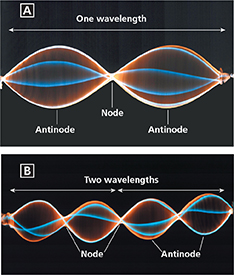Standing Waves
If you tie one end of a rope to a chair and shake the other end, waves travel up the rope, reflect off the chair, and travel back down the rope. Interference occurs as the incoming waves pass through the reflected waves. At certain frequencies, interference between a wave and its reflection can produce a standing wave. A standing wave is a wave that appears to stay in one place—it does not seem to move through the medium.
You can observe a standing wave if you pluck a guitar string or any elastic cord. Only certain points on the wave, called nodes, are stationary. A node is a point on a standing wave that has no displacement from the rest position. At the nodes, there is complete destructive interference between the incoming and reflected waves. An antinode is a point where a crest or trough occurs midway between two nodes.
Why does a standing wave happen only at particular frequencies?  A standing wave forms only if half a wavelength or a multiple of half a wavelength fits exactly into the length of a vibrating cord. In Figure 13A, the wavelength equals the length of the cord. In Figure 13B, the wave-length is halved. You can adjust the wavelength by changing the frequency of the waves. Once you find a frequency that produces a standing wave, doubling or tripling the frequency will also produce a standing wave.
A standing wave forms only if half a wavelength or a multiple of half a wavelength fits exactly into the length of a vibrating cord. In Figure 13A, the wavelength equals the length of the cord. In Figure 13B, the wave-length is halved. You can adjust the wavelength by changing the frequency of the waves. Once you find a frequency that produces a standing wave, doubling or tripling the frequency will also produce a standing wave.
Figure 13 These photos show standing waves for two different frequencies. A One wavelength equals the length of the cord. B Two wavelengths equal the length of the cord.
Interpreting Photos In which photo do the waves have a longer wavelength?

Section 17.3 Assessment
Reviewing Concepts
 How is a wave changed by reflection?
How is a wave changed by reflection? What causes refraction when a wave enters a medium at an angle?
What causes refraction when a wave enters a medium at an angle? What determines how much a wave diffracts when it encounters an opening or an obstacle?
What determines how much a wave diffracts when it encounters an opening or an obstacle? List the types of interference.
List the types of interference. At what wavelengths can a standing wave form in an elastic cord?
At what wavelengths can a standing wave form in an elastic cord?
Critical Thinking
Comparing and Contrasting How does the frequency of a reflected wave compare to the frequency of the incoming wave?
Comparing and Contrasting How are diffraction and refraction similar? How are they different?
Applying Concepts What is the amplitude of the wave that results when two identical waves interfere constructively?
Writing in Science
Explain a Sequence Imagine you are floating in a wave pool. The crest of one wave hits you from the left just as the crest of another hits you from the right. The two waves are otherwise identical. A friend takes a series of five photos starting when the crests hit you. Write a paragraph describing the photos.




